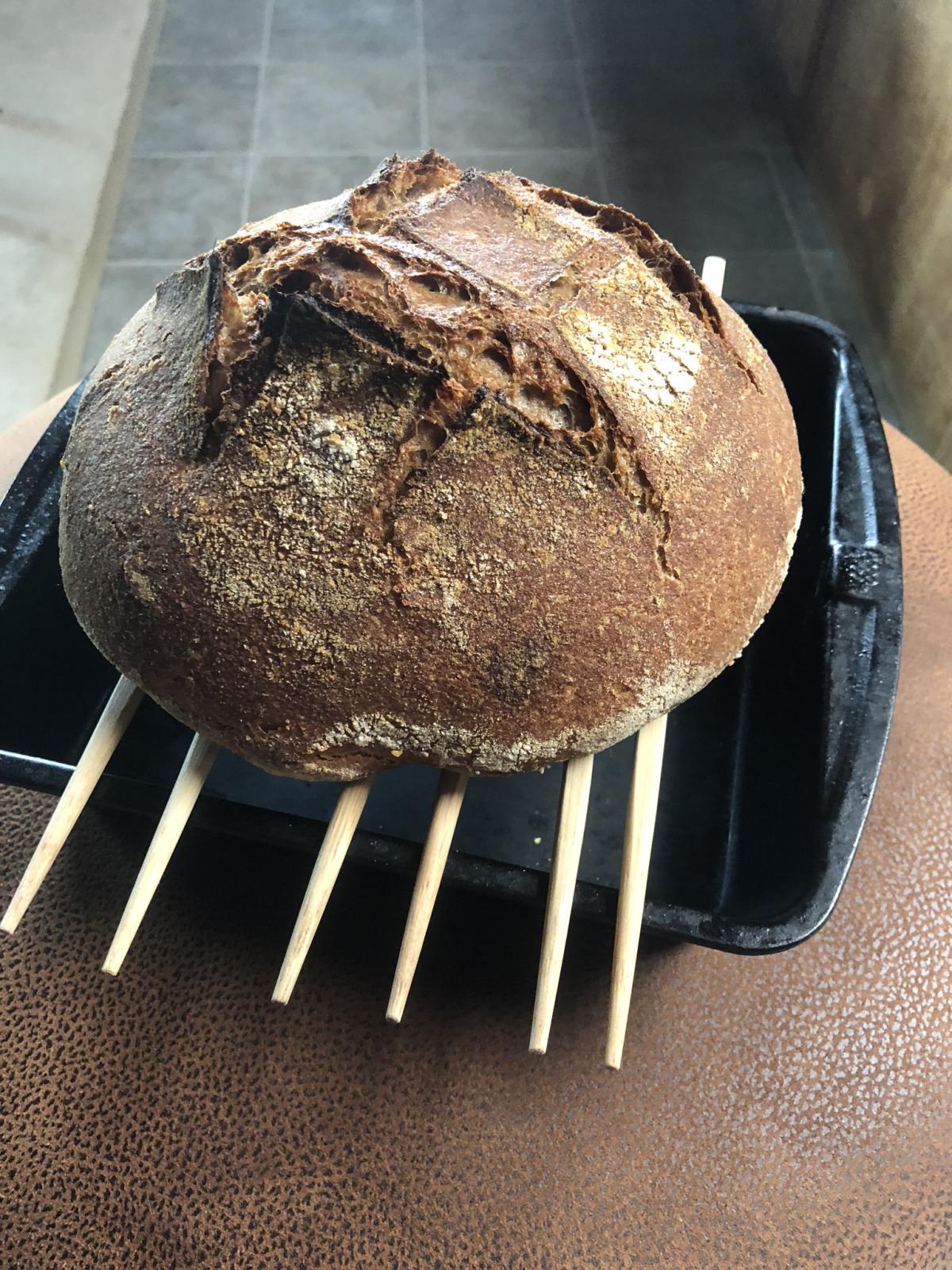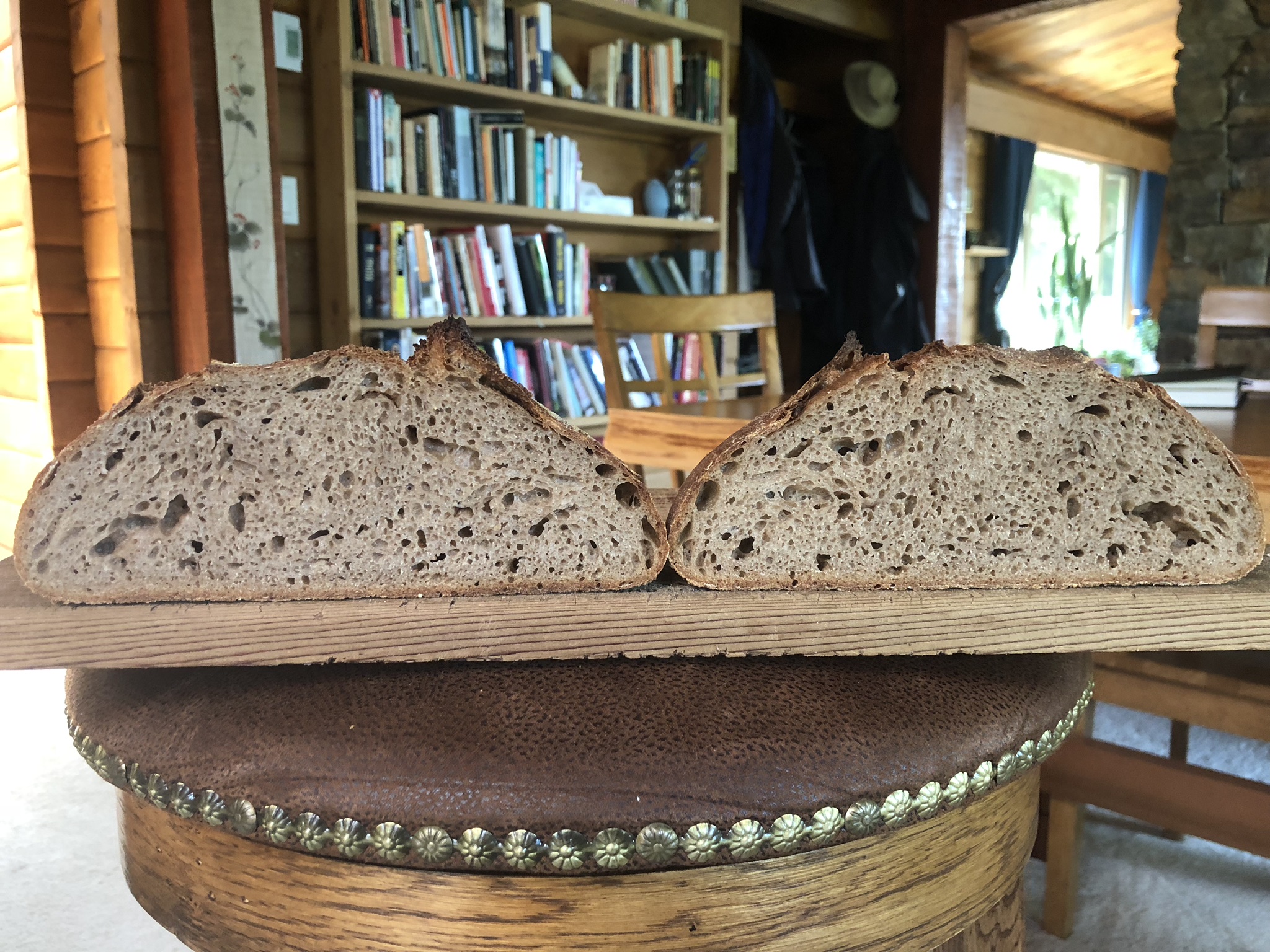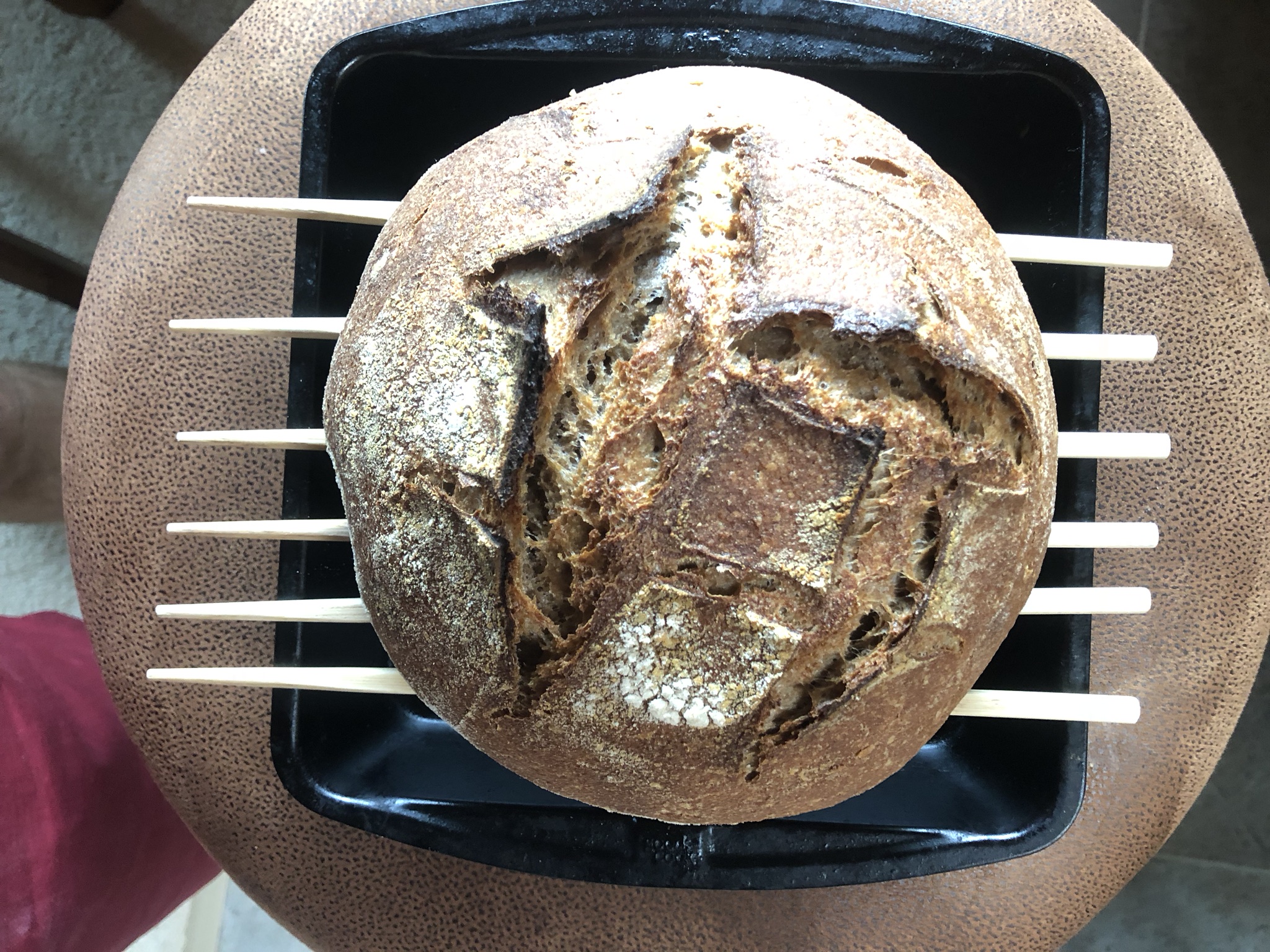Apologies for the longer post but I'm really hoping to learn a lot from this one.
100% WG organic. 85% red fife, 15% rye. Fresh hand milled. No rest between mill and mix. 90% hydr. 10% prefermented red fife flour @ 100% hydr levain NMNF, 3x build at 32c/90f then a 36 hour levain fridge retard. 50 min AL. Add levain, 10 min rest. Add 1.8% salt. 150 SL&F, 5 min rest, 150 SL&F. Bowl folds every 20m x 3, then every 30-40 min. No folds last hour.
I took a small piece of dough from the main dough after SL&Fs at the start of the bulk. That went into a small narrow glass jar (call it "SJ") and the level marked with an elastic to monitor its size in the hopes of gauging the size increase of the main dough in the glass bowl. After 3.5 hours of bowl fermenting and the folds, the SJ dough had not moved, and the main dough in the bowl barely moved. Room temp of around 24c/77f. There was much alveoli development and some surface disruption of bubbles and a domed shape to the dough so it looked like there was fermentation. The dough seemed to develop more strength than when I started.
I had to end bulk due to time constraints. The dough was so structureless and wet it was almost unworkable. Shaped it into a messy boule, gave it a 15 min bench rest. A final shape that again had even less structure. Just a mess. Rice floured banneton. I almost poured in the dough like a batter. 9 hour retard at 3c. By morning the dough was unchanged, had not expanded, but more firm from the cold. 30 min counter rest in the morning at 22c. Oven 45 min preheat with DO, 475. Score and sprtiz. 20m. Uncover 15m at 430. 5 min at 420.
I could not believe this dough sprung over 2x in the oven. I thought it was a dud for sure.
The SJ dough did not expand either during the night. After an hour on the counter, the SJ was 15% above the elastic.
After a 3.5 hour bulk, a 9 hour retard, and then 4 more hours on the counter, SJ dough had increased about 50%.
After a 3.5 hour bulk, a 9 hour retard, and then 6 more hours on the counter, the SJ dough had doubled, it stayed that size for a couple hours before falling.
Now, so many questions:
1. The NMNF started favours Lab development over yeast. Then I further favoured the Lab by a 32c 12 hour feeding. Were the bubbles formed in bulk from the Lab given there was no size increase? Was the slow bulk shown by both the main dough and the SJ due to the lower amounts of yeast?
2. Is it surprising it took about 9.5 hours + a 9 hour retard for the SJ dough to double?
3. The dough had so much spring and bloom. Makes me think it was underproofed even with 3.5 hour bulk at a warm room temp. Agree? Is this suboptimal given how much it rose in the end?
4. With 100% whole grain, do you have much for gluten development after 300 SL&F? The dough was cohesive, not sticking to the wood cutting board much. Extensible. Very different from the start. But not silky like AP flour. Is that standard?
5. I think I should be handling the dough as little as possible after bulk b/c the dough proceeded to lose all strength the longer I tension pulled and shaped with the bench scraper.
6. This was essentially a pan loaf given the lack of structure. It was all banneton and retard giving it form.
7. What can we learn about the SJ dough?
8. Is the 32c levain build too much for a 100% WG fresh-milled NMNF starter?
Next loaf I plan on a 2 hour AL. I also need to get better at the hash score. Need to watch more wet dough handling vids as this was a mess, whereas the 85% was a breeze--probably lack of dough strength.
Thanks for the help.
-Tom



the bubbles in the bulk were from yeast not LAB, If you made the NMNF starter at 32 C then the LAB were favored over yeast 3 to 1. since you built the levain at that temperature the yeast were restricted ike it was 19 C but the LAB were crankingat a 3 to 1 rate.
Since the levain was so small and the yeast had bee restricted you have to expect that bulk and retard are going to be slow. The bread sprang and bloomed great and that crumb for a 100% whole grain bread is to die for! Whole grain breads was what the NMNF starter, bran levain, high temp counter work and cold retard process was designed for. Not surprising that the bred is just perfect and I bet it is sour too. Nice
Happy baking
The amount of levain makes for a long lag time until you see the dough rise. About 4 hours nothing visible is happening but the dough is filling with lots of very tiny gas bubbles. Just a few degrees warmer will speed up the yeast growth considerably if desired for a less sour tasting outcome. Rye will slightly stiffen the dough as it cools when compared to an all wheat dough so I'm not so surprised it didn't rise much in the fridge but the potential is there for great expansion when warmed or put into the oven when gas expands. There isn't a lot of rye in the formula but you will notice more rye behavior as the rye % increases in dough.
Greatly appreciate the comments Dabrownman and Minioven. I am still amazed that the proxy dough in the small jar took about 9.5 hours + a 9 hour retard to double in size. Seems only using 10% prefermented flour, the greater Lab rates from the NMNF starter, and the 32c levain build made for dramatic results in delayed dough expansion in bulk.
Thanks.
fermenting times together instead of looking at them separately can be deceiving. I prefer to read #2 with before and after retarding times. If the dough was only one hour fermenting before the retard, it might take much longer to bulkrise.
Good point, thanks. This particular loaf and the small jar proxy had a 3.5 hour bulk at about 24c, then a 9 hour retard at 3c, and then the SJ had another 9 hours at room temp before doubling.